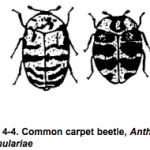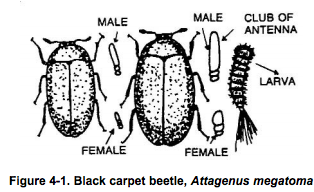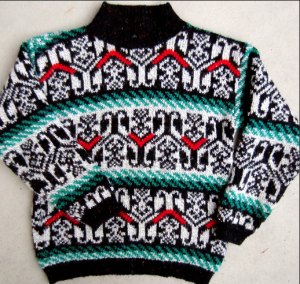 Carpet beetles can be one of the most difficult pests to treat but it used to be a lot worse. As close to an omnivore as you can get, carpet beetles have a knack of finding food in some of the most obscure places which makes finding the source very difficult. What’s more, even if you find the original attraction, you may still have to deal with more beetles that have spread out and found other food sources. Attics, wall voids, storage, clothing, carpets, lint, furniture, draperies, dried flowers, dead carcasses, taxidermy, insect collections, furs abandon wasp or bees nest, etc. etc. The carpet beetle is truly one of natures prime recyclers.
Carpet beetles can be one of the most difficult pests to treat but it used to be a lot worse. As close to an omnivore as you can get, carpet beetles have a knack of finding food in some of the most obscure places which makes finding the source very difficult. What’s more, even if you find the original attraction, you may still have to deal with more beetles that have spread out and found other food sources. Attics, wall voids, storage, clothing, carpets, lint, furniture, draperies, dried flowers, dead carcasses, taxidermy, insect collections, furs abandon wasp or bees nest, etc. etc. The carpet beetle is truly one of natures prime recyclers.
Years ago, treatment for carpet beetles was much like a flea job. A course fan spray was applied to the carpets and/or furniture and removal of any infested articles was about the extent of it. Well, until the complaint calls would start coming in a few weeks later. Back then, more natural fabrics were used in our clothes and furniture and almost every home was a true smorgasbord for the beetle. Also, since we didn’t have today’s products (namely IGR’s-integrated growth regulators and pheromones) It was often times a long lengthy battle and the client was the one who most often suffered the loss.
At present, so much of our clothing, furniture and carpets are more synthetic than anything which has served to greatly limit the widespread infestations of yesteryear. Still, I see this pest on a regular basis and often times my clients are taken aback when I search for more than just a wool sweater. It SHOULD be at least an exhaustive inspection and hopefully just a minor treatment.
What To Look For
Adults and damage are often the first thing one finds with a carpet beetle infestation. Adults are pretty good fliers and often times come in from outside looking for food or a place to lay eggs. Window sills are a common place to find the adult.
come in from outside looking for food or a place to lay eggs. Window sills are a common place to find the adult.
All beetles undergo complete metamorphosis and in the immature stage have several larval instars (stages between molts). Of the 4 species that cause serious damage you can have anywhere from 5 to 20 instars and their complete life cycle can be as little as 3 months or as much as 650 days. It isn’t uncommon to find many of the cast skins near damaged material.Larva can be light averse but will migrate freely to find more food or a protected place to molt or finally pupate. So finding larvae is extremely helpful but don’t limit your search with just this.
Black Carpet Beetle, Attagenus megatoma Adults distinctly oval, dark brown to black, about 1/6 inch long. Larvae carrot-shaped with long tail bristles. Shiny brown to black.
Varied Carpet Beetle Anthrenus verbasci Adults slightly oval shaped and mottled with white, brownish and yellowish scales. No cleft at tip of wings. Larval body wedge-shaped with rear broader than head. Three tufts of hair on either side of rearend.
Furniture Carpet Beetle, Anthrenus flavipes Adults mottled with yellow, black and white, more rounded than varied carpet beetles, cleft at tip of wings. Larvae torpedo-shaped, head wider than rear, darker than varied carpet beetle.
Common Carpet Beetle, Anthrenus scrophulariae Adults round-oval, about 1/8 inch long, black with orange red scales. Scalloped band of orange down center of back. Larvae reddish brown, with hair extending outward from entire body.
How To Treat
With your inspection you should note all the places you found any evidence. If it is clothing or an article that can be dry cleaned or laundered that should suffice. For items that cannot be laundered nor sprayed and throwing them away is not desirable, Nuvan Pest Strips can be utilized. By placing the articles in a plastic bag or large sealable container along with a pest strip, the chemical in the activated strip will kill the beetles/larvae and not harm the contents. Be sure to follow the label. Please note; Moth balls are not the best option. The smell alone will make you want to throw away the treated items once you take them out.
laundered that should suffice. For items that cannot be laundered nor sprayed and throwing them away is not desirable, Nuvan Pest Strips can be utilized. By placing the articles in a plastic bag or large sealable container along with a pest strip, the chemical in the activated strip will kill the beetles/larvae and not harm the contents. Be sure to follow the label. Please note; Moth balls are not the best option. The smell alone will make you want to throw away the treated items once you take them out.
For carpets or other areas, a residual insecticide (Suspend SC-Demand CS) with a IGR (Nylar-Archer-Gentrol) is your best bet AFTER you have had the areas cleaned. Some research seems to say that there isn’t enough ‘protein’ in wool or fabrics alone so these pests will tend to infest areas that are soiled by spilled food, urine or even perspiration. Cleaning will also help to remove excess food sources like lint or hair etc. Once cleaned, apply your mix as a spot treatment, be sure to penetrate the fabric or carpet and if possible do the underneath side as well. Edges and darkened areas are most prone to attack so you should consider treating in those areas as well. Continue constant vacuuming etc. even after your application until the problem is resolved.
remove excess food sources like lint or hair etc. Once cleaned, apply your mix as a spot treatment, be sure to penetrate the fabric or carpet and if possible do the underneath side as well. Edges and darkened areas are most prone to attack so you should consider treating in those areas as well. Continue constant vacuuming etc. even after your application until the problem is resolved.
If it’s a wall void or other type of cavity where you’ve determined the beetle to be, insecticide dusts (Boric acid-Delta-Drione-Alpine-Pyganic) can be very effective. This may be the case if there were a dead mouse in the wall or an abandoned bird nest in the attic.
To monitor your success you don’t have to wait on more damage showing up. Pheromone sticky traps are available online and you can place several around to try and capture adults. I’d give the treatment a week or so before placing these so as to let your treatment have full effect and you’re not just catching some that were already there and most likely going to die anyway.
Carpet beetles are a situation where you don’t always know just how you’re doing because of the length of cycles and the vast areas  they can infest and find food. The good news is that your IGR treatment will last quite sometime so don’t lose heart in your treatment. Resprays aren’t always called for but a constant regiment of cleaning and reducing food sources is. Check your pheromone traps, look for more cast skins and have faith in today’s modern technology– and of course that beautiful polyester sweater you just had to have. 😉 Some things just never change.
they can infest and find food. The good news is that your IGR treatment will last quite sometime so don’t lose heart in your treatment. Resprays aren’t always called for but a constant regiment of cleaning and reducing food sources is. Check your pheromone traps, look for more cast skins and have faith in today’s modern technology– and of course that beautiful polyester sweater you just had to have. 😉 Some things just never change.




